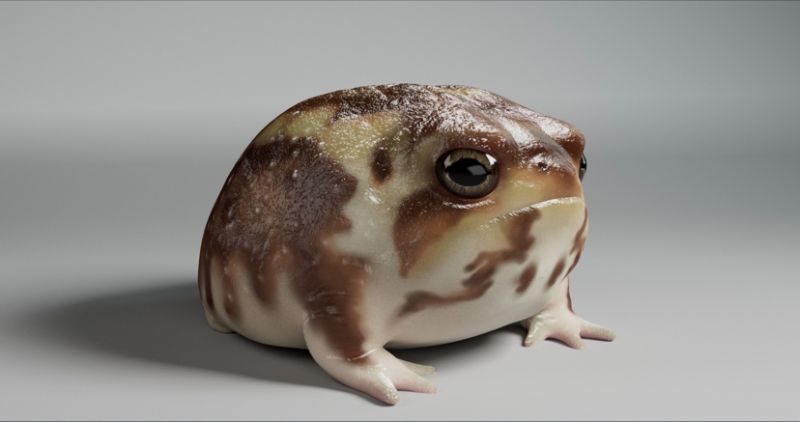With their round, "grumpy" faces and endearing squeaks, Desert Rain Frogs have captured the hearts of amphibian lovers worldwide. As exotic pets, they have grown in popularity thanks to their unique appearance and intriguing habits. If you're considering caring for one of these fascinating creatures, here's a detailed guide on everything you need to know.

The Desert Rain Frog is one of the smallest amphibians, typically reaching just 1 inch (2.5 cm) in length when fully grown. Their plump, rounded bodies and triangular-shaped heads give them a distinctive look. Their skin is smooth and varies in shades of beige, cream, and light brown, blending perfectly into their natural habitat.
| Characteristic | Details |
|---|---|
| Body Shape | Rounded, with prominent folds on hind legs |
| Eye Shape | Large, jet-black with horizontal pupils |
| Color | Beige, brown, or cream with subtle patterns |
| Feet | Long, spindly toes for digging |
One of the standout features of the Desert Rain Frog is its large, black eyes with sideways pupils, adapted to help them see better during nighttime activities.
As their name suggests, Desert Rain Frogs are native to desert environments. They inhabit the Namib Desert in Namibia and parts of South Africa, thriving in areas like:
Gravel plains and sandy margins
Dry riverbeds and rocky outcroppings
During the hot daylight hours, these frogs stay buried underground to escape the heat. They emerge at night to hunt small invertebrates, using their size to burrow into small crevices for protection.
A fascinating aspect of the Desert Rain Frog is its reproduction during rare rainstorms. For most of the year, they remain underground in a dormant state. However, after heavy rain, male frogs surface and begin their loud mating calls, which sound like soft snores.
Breeding Cycle: They lay eggs in ephemeral rain pools.
Tadpole Development: Tadpoles quickly transform into froglets before the water dries up.
These frogs are territorial and solitary creatures, preferring to remain hidden until necessary. When threatened, they may jump away or burrow quickly to escape danger.
For a single Desert Rain Frog, a 10 to 20-gallon terrarium is ideal. Ensure the enclosure has a secure mesh lid to prevent escapes, as these frogs are skilled climbers.
| Enclosure Feature | Recommendation |
|---|---|
| Size | 10-20 gallons for one frog |
| Lid Type | Secure screen top to prevent escape |
| Floor Space | Ample space for hopping and exploring |
A 3-4 inch layer of coconut fiber or organic topsoil works best. Avoid materials like sand or gravel, as ingestion can lead to impaction.
Moisture Level: The substrate should be moist but not waterlogged.
Cleaning Routine: Spot clean daily and replace the substrate every 2-3 months.
Include hiding spots to mimic the frog’s natural habitat:
Curved cork bark and log hides
Clay plant pots and artificial foliage
A humid hide with sphagnum moss or coco fiber to aid hydration.
Maintain daytime temperatures of 75-85°F and nighttime temperatures of 65-75°F. Use a digital thermometer to monitor accurately. Avoid "hot rocks" as they can cause burns.
| Temperature Requirement | Details |
|---|---|
| Daytime Temperature | 75–85°F (24–29°C) |
| Nighttime Temperature | 65–75°F (18–24°C) |
| Lighting | 12-hour day/night cycle |
Maintain humidity levels between 40-60% using a hygrometer. Lightly mist the enclosure 1-2 times daily but avoid spraying the frog directly. Ensure the water dish is filled with dechlorinated water for soaking.
In the wild, Desert Rain Frogs are insectivores. They consume:
Replicate their natural diet by offering live feeder insects.
| Feeder Insect | Description |
|---|---|
| Crickets | High in protein, available in most pet stores |
| Mealworms | Offer as occasional treats due to fat content |
| Waxworms | Fatty, should be given sparingly |
| Roaches | Nutritionally rich and easy to digest |
Insect Size: Insects should be no larger than the space between the frog’s eyes to prevent choking.
Feeding Frequency: Juveniles require daily feedings, while adults can be fed every 2-3 days.
To prevent deficiencies, dust feeder insects with calcium and multivitamin supplements.
Recommended Supplements:
Repashy Calcium Plus
Zoo Med Repti Calcium
Exo Terra Calcium + D3
Alternate between calcium and multivitamin powders to ensure balanced nutrition.
These frogs are delicate and only 0.6 to 1.25 inches long, requiring gentle care. When handling:
Avoid sudden movements to prevent startling the frog.
Support their entire body with cupped hands.
Due to their permeable skin, ensure your hands are clean and chemical-free. Frequent handling can stress the frog and weaken its immunity.
A charming feature of Desert Rain Frogs is their vocalizations. During mating season, males produce high-pitched squeaks to attract females. When distressed, they may also make louder squeaks or clicking sounds by retracting their eyes, helping them retain moisture.
Monitor your Desert Rain Frog for signs of health problems, such as:
Lethargy and loss of appetite
Improper shedding or skin lesions
Swollen eyes or labored breathing
To maintain a healthy habitat:
Spot clean daily and replace water frequently.
Quarantine new frogs before introducing them to prevent the spread of pathogens.
Schedule annual fecal exams to detect parasites early.
Desert Rain Frogs are truly unique and captivating pets. Their "grumpy" expressions and amusing squeaks make them a delightful addition to any amphibian collection. However, they require a specific care routine involving proper habitat, diet, and humidity control. By providing the right environment and nutrition, you can ensure your Desert Rain Frog stays healthy and happy, rewarding you with its fascinating behavior for years to come.
animal tags: Desert rain frog
We created this article in conjunction with AI technology, then made sure it was fact-checked and edited by a Animals Top editor.